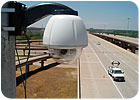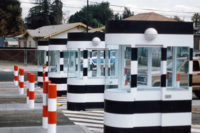From Bow-wow to Oh-wow

Ever notice that when you blow in a dog’s face, he gets mad at you. But when you take him in a car, he sticks his head out the window, big old ears flapping in the wind.
Most dogs love riding in a car. So do most people. Vehicles, ranging from those little Mini Coopers and giant Hummers to tracker-trailer trucks, are the life’s blood of America and its economy. There also are security concerns: folks run red lights; accidents and incidents on tollways; and even terror threats from trucks loaded with explosives.
According to the Insurance Institute for Highway Safety, drivers running red lights cause about 22 percent of all traffic accidents, killing some 800 people annually while causing an estimated $7 billion dollars in property damage, medical bills, lost productivity and insurance hikes.

The North Texas Tollway Authority has an upgrade pan from analog video to IP-based cameras. A dual IP/analog interface provides seamless migration of the existing 600-plus surveillance cameras.
Red-light Cameras
To fight the problem and, by the way, generate revenue for cities and their outsourced partners, so-called red-light cameras collect all of the evidence authorities need to prosecute light-runners. If a camera catches you speeding through the intersection, you can expect a ticket (along with a photograph of the violation) to arrive in your mailbox a month or two later. There are controversies – a U.S. House panel heard testimony suggesting some red-light vendors reset the “yellow” light to display and change to red more quickly and lawsuits propose unfairness when the owner of the auto is not the driver at the time of an infraction.Analytics also has a growing role viewing, tracking and protecting vehicle traffic.
For example, the North Texas Tollway Authority (NTTA) is upgrading from analog video to IP-based cameras from Sony. The dual IP/analog interface allows for a seamless migration of the existing 600-plus surveillance cameras, tollway officials told The Zalud Report, as well as providing an analog solution while backend content analytics makes the transition to IP for the more than 200-plus traffic cameras covering 54 miles of Texas toll facilities in the Dallas Metroplex. Said James Hofmann, director of IT at the NTTA, “The system lowers the total cost of ownership compared to our legacy security video installation, while improving the safety and satisfaction of our customers.”
The system monitors 1.3 million daily toll transactions. First, it monitors conditions on the roadway for any situation or condition that might slow traffic or put travelers at risk. Second, it guards each toll plaza and on ramp, protecting property and personnel from criminal activity.
“Our legacy system worked fine, it’s just that there was no way we could evolve and advance with it,” said Marty Legé, NTTA command center manager. “IP is where everything is going because of the new applications and the new opportunities they afford. Automated detection is essential to operating a system like this effectively, and it is clear that the IP platform is where the content analysis developers are moving and so we move with them.”
Other security scenarios view vehicles as rolling bombs.
In New York City, and after the tragedy of Sept. 11th, many high-rise buildings installed bollards and barriers. More recently, some of those installations have been dismantled. But there still is no doubt that high impact vehicle barriers have an important security role.
There are a range of barriers including independently certified bollards, road blockers and beams, all should be tested and certified to internationally recognized U.S. Department of State standards to prevent aggressive vehicle intrusion at high-risk sites.
Zalud’s Report previewed hydraulic bollards, for example, from Boon Edam Tomsed, that combine an open, aesthetic appearance, combining free movement of pedestrians with a high level of perimeter control.
These barriers have traditionally been associated with government and military sites; but more organizations now consider use as the threat of terrorist attacks -- softer targets such as nuclear, pharmaceutical and petrochemical plants.
Looking for a reprint of this article?
From high-res PDFs to custom plaques, order your copy today!







